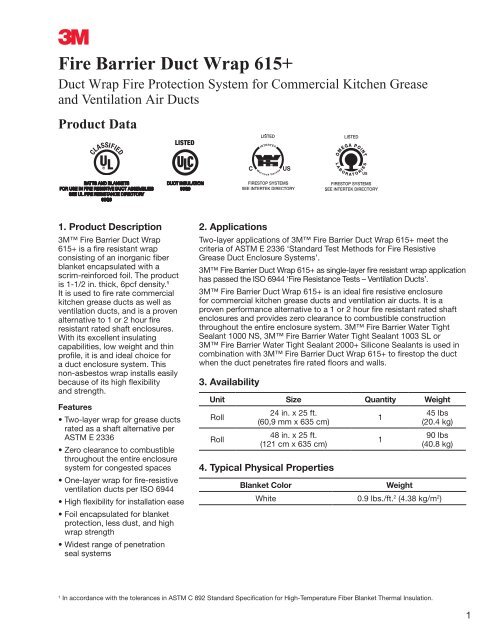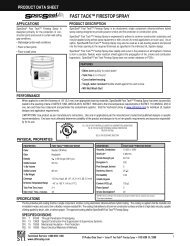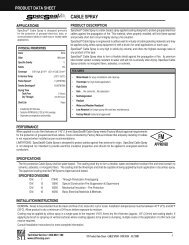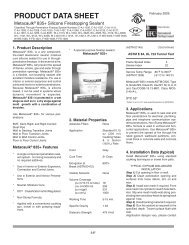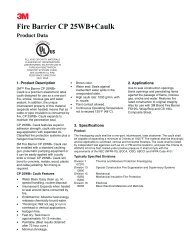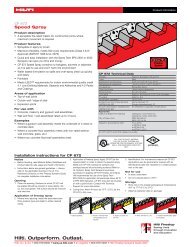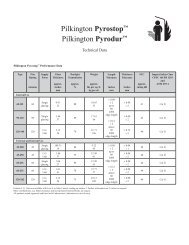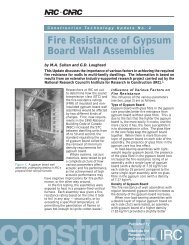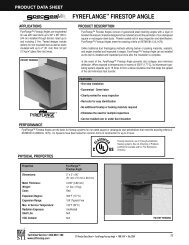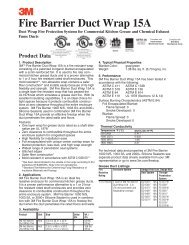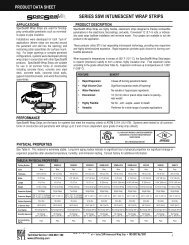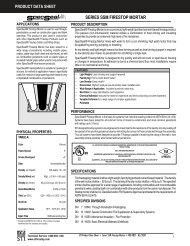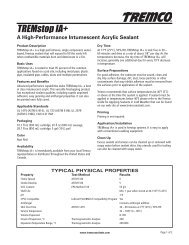Create successful ePaper yourself
Turn your PDF publications into a flip-book with our unique Google optimized e-Paper software.
<strong>Fire</strong> <strong>Barrier</strong> <strong>Duct</strong> <strong>Wrap</strong> <strong>615+</strong><br />
<strong>Duct</strong> <strong>Wrap</strong> <strong>Fire</strong> Protection System for Commercial Kitchen Grease<br />
and Ventilation Air <strong>Duct</strong>s<br />
Product Data<br />
Batts and blankets<br />
for use in fire resistive duct assemblies<br />
see UL fire resistance directory<br />
90G9<br />
<strong>Duct</strong> Insulation<br />
90G9<br />
1. Product Description<br />
3M <strong>Fire</strong> <strong>Barrier</strong> <strong>Duct</strong> <strong>Wrap</strong><br />
<strong>615+</strong> is a fire resistant wrap<br />
consisting of an inorganic fiber<br />
blanket encapsulated with a<br />
scrim-reinforced foil. The product<br />
is 1-1/2 in. thick, 6pcf density. 1<br />
It is used to fire rate commercial<br />
kitchen grease ducts as well as<br />
ventilation ducts, and is a proven<br />
alternative to 1 or 2 hour fire<br />
resistant rated shaft enclosures.<br />
With its excellent insulating<br />
capabilities, low weight and thin<br />
profile, it is and ideal choice for<br />
a duct enclosure system. This<br />
non-asbestos wrap installs easily<br />
because of its high flexibility<br />
and strength.<br />
Features<br />
• Two-layer wrap for grease ducts<br />
rated as a shaft alternative per<br />
ASTM E 2336<br />
• Zero clearance to combustible<br />
throughout the entire enclosure<br />
system for congested spaces<br />
• One-layer wrap for fire-resistive<br />
ventilation ducts per ISO 6944<br />
• High flexibility for installation ease<br />
• Foil encapsulated for blanket<br />
protection, less dust, and high<br />
wrap strength<br />
• Widest range of penetration<br />
seal systems<br />
2. Applications<br />
Two-layer applications of 3M <strong>Fire</strong> <strong>Barrier</strong> <strong>Duct</strong> <strong>Wrap</strong> <strong>615+</strong> meet the<br />
criteria of ASTM E 2336 ‘Standard Test Methods for <strong>Fire</strong> Resistive<br />
Grease <strong>Duct</strong> Enclosure Systems’.<br />
3M <strong>Fire</strong> <strong>Barrier</strong> <strong>Duct</strong> <strong>Wrap</strong> <strong>615+</strong> as single-layer fire resistant wrap application<br />
has passed the ISO 6944 ‘<strong>Fire</strong> Resistance Tests – Ventilation <strong>Duct</strong>s’.<br />
3M <strong>Fire</strong> <strong>Barrier</strong> <strong>Duct</strong> <strong>Wrap</strong> <strong>615+</strong> is an ideal fire resistive enclosure<br />
for commercial kitchen grease ducts and ventilation air ducts. It is a<br />
proven performance alternative to a 1 or 2 hour fire resistant rated shaft<br />
enclosures and provides zero clearance to combustible construction<br />
throughout the entire enclosure system. 3M <strong>Fire</strong> <strong>Barrier</strong> Water Tight<br />
Sealant 1000 NS, 3M <strong>Fire</strong> <strong>Barrier</strong> Water Tight Sealant 1003 SL or<br />
3M <strong>Fire</strong> <strong>Barrier</strong> Water Tight Sealant 2000+ Silicone Sealants is used in<br />
combination with 3M <strong>Fire</strong> <strong>Barrier</strong> <strong>Duct</strong> <strong>Wrap</strong> <strong>615+</strong> to firestop the duct<br />
when the duct penetrates fire rated floors and walls.<br />
3. Availability<br />
Unit Size Quantity Weight<br />
Roll<br />
Roll<br />
24 in. x 25 ft.<br />
(60,9 mm x 635 cm)<br />
48 in. x 25 ft.<br />
(121 cm x 635 cm)<br />
4. Typical Physical Properties<br />
Blanket Color<br />
1<br />
1<br />
Weight<br />
45 lbs<br />
(20.4 kg)<br />
90 lbs<br />
(40.8 kg)<br />
White 0.9 lbs./ft. 2 (4.38 kg/m 2 )<br />
1 In accordance with the tolerances in ASTM C 892 Standard Specification for High-Temperature Fiber Blanket Thermal Insulation.<br />
1
5. Performance<br />
A. 3M <strong>Fire</strong> <strong>Barrier</strong> <strong>Duct</strong> <strong>Wrap</strong> <strong>615+</strong> has been tested in<br />
accordance with the following:<br />
ASTM E 2336<br />
ASTM E 119<br />
ASTM E 814<br />
ASTM E 136<br />
ASTM C 518<br />
ASTM C 1338<br />
ASTM E 84<br />
ISO 6944-85<br />
Standard Test Methods for <strong>Fire</strong> Resistive Grease <strong>Duct</strong><br />
Enclosure Systems<br />
Standard Test Methods for <strong>Fire</strong> Tests of Building Construction<br />
and Materials<br />
Standard Test Method for <strong>Fire</strong> Tests of Through-Penetration<br />
<strong>Fire</strong> Stops<br />
Standard Test Method for Behavior of Material in a Vertical<br />
Tube Furnace at 750ºC (1382°F)<br />
Standard Test Method for Steady-State Thermal Transmission<br />
Properties by Means of the Heat Flow Meter Apparatus<br />
Standard Test Method for Determining Fungi Resistance of<br />
Insulation Materials and Facings<br />
Standard Test Method for Surface Burning Characteristics of<br />
Building Materials<br />
<strong>Fire</strong> Resistance Tests – Ventilation <strong>Duct</strong>s<br />
B. Surface Burning Characteristics (ASTM E 84, ULC/CAN S-102)<br />
Flame Spread<br />
Smoke Developed<br />
Foil Encapsulated Blanket
6. Installation Techniques<br />
3M <strong>Fire</strong> <strong>Barrier</strong> <strong>Duct</strong> <strong>Wrap</strong> <strong>615+</strong> should be installed per the application design listing in accordance with the<br />
following basic installation instructions.<br />
A. Material and Equipment<br />
• 3M <strong>Fire</strong> <strong>Barrier</strong> <strong>Duct</strong> <strong>Wrap</strong> <strong>615+</strong> blanket, 1-1/2 in.<br />
(38 mm) thick 2 , 24 in. (60 cm) or 48 in. (121 cm)<br />
wide, 25 ft. (635 cm) standard length. The 48 in.<br />
(121 cm) wide blanket helps to minimize waste.<br />
• Aluminum foil tape.<br />
• Minimum 3/4 in. (19 mm) wide filament tape.<br />
• Stainless steel banding material, minimum 1/2 in.<br />
(12,7 mm) wide, minimum 0.015 in. (0,38 mm) thick,<br />
with stainless steel banding clips.<br />
• Hand banding tensioner, crimping tool and<br />
banding cutter.<br />
• Minimum 12 gauge copper-coated steel insulation<br />
pins used with minimum 2-1/2 in. (38 mm) square<br />
galvanized steel or stainless speed clips or 1-1/2 in.<br />
(38 mm) dia. round or equivalent sized insulated<br />
cup-head pins.<br />
• Capacitor discharge stud gun.<br />
• Access door hardware: four galvanized steel thread<br />
rods, 1/4 in. (6 mm) diameter by minimum 6 in. long<br />
(152 mm) with 1/4 in. (6 mm) wing nuts and 1/4 in.<br />
(6 mm) washers.<br />
• 4 in. (102 mm) long steel hollow tubing to fit<br />
threaded rods.<br />
• Minimum 4 pcf (64 kg/m 3 ) density mineral wool or<br />
scrap pieces of 3M <strong>Fire</strong> <strong>Barrier</strong> <strong>Duct</strong> <strong>Wrap</strong> <strong>615+</strong>.<br />
• 3M <strong>Fire</strong> <strong>Barrier</strong> Water Tight Sealant 1000 NS, 1003<br />
SL or 3M <strong>Fire</strong> <strong>Barrier</strong> Silicone Sealant 2000+.<br />
B. Storage<br />
The 3M <strong>Fire</strong> <strong>Barrier</strong> <strong>Duct</strong> <strong>Wrap</strong> <strong>615+</strong> and 3M <strong>Fire</strong><br />
<strong>Barrier</strong> Water Tight Sealant 1000 NS, 1003 SL or<br />
3M <strong>Fire</strong> <strong>Barrier</strong> Silicone Sealant 2000+ must be<br />
stored in a dry warehouse environment. Pallets<br />
should not be stacked.<br />
C. Preparatory Work<br />
3M <strong>Fire</strong> <strong>Barrier</strong> <strong>Duct</strong> <strong>Wrap</strong> <strong>615+</strong> is installed with<br />
common tools, such as knives, banders and capacitor<br />
discharge guns for applying insulation pins. In order to<br />
install the duct firestop system, the surfaces of all the<br />
openings and penetrating items need to be clean, dry,<br />
frost free and free of dust.<br />
D. Method (Two-Layer for ASTM E 2336)<br />
Note: These general instructions for installing<br />
3M <strong>Fire</strong> <strong>Barrier</strong> <strong>Duct</strong> <strong>Wrap</strong> <strong>615+</strong> include a two-layer<br />
wrap construction of 24-inch 3M <strong>Fire</strong> <strong>Barrier</strong> <strong>Duct</strong><br />
<strong>Wrap</strong> <strong>615+</strong> blanket applied directly to a grease duct.<br />
To minimize waste, 3M <strong>Fire</strong> <strong>Barrier</strong> <strong>Duct</strong> <strong>Wrap</strong> <strong>615+</strong><br />
material should be rolled out tautly before measuring.<br />
The first layer of 3M <strong>Fire</strong> <strong>Barrier</strong> <strong>Duct</strong> <strong>Wrap</strong> <strong>615+</strong><br />
blanket is wrapped around the perimeter of the duct<br />
and is cut to a length to overlap itself not less than<br />
3 in. (76 mm). The overlap made by adjacent blankets<br />
forms the “longitudinal” overlap. Aluminum foil tape is<br />
used to seal all cut edges of the blanket and any tears<br />
in the foil scrim. This first layer is temporarily held in<br />
place using filament tape. The first layer does not<br />
require stainless steel banding.<br />
The second layer of 3M <strong>Fire</strong> <strong>Barrier</strong> <strong>Duct</strong> <strong>Wrap</strong> <strong>615+</strong><br />
blanket is wrapped around the perimeter of the<br />
previously installed first layer of <strong>615+</strong>, and is cut to at<br />
length to overlap itself not less that 3 in. (76 mm). The<br />
centerline of the second layer of blanket should be<br />
centered over the overlap of the first layer. The second<br />
layer of blanket requires longitudinal overlap onto<br />
adjacent blankets of not less than 3 in. (76 mm). The<br />
second layer of blanket is also held in place using<br />
filament tape. The second layer of wrap requires<br />
permanent fastening with stainless steel banding or<br />
rows of weld pins (impaling or cup-head style).<br />
2 In accordance with the tolerances in ASTM C 892 Standard Specification for High-Temperature Fiber Blanket Thermal Insulation.<br />
3
Figure 1<br />
3M <strong>Fire</strong> <strong>Barrier</strong> <strong>Duct</strong> <strong>Wrap</strong> <strong>615+</strong> Commercial Kitchen Grease <strong>Duct</strong> Systems<br />
1 or 2 Hour Shaft Alternative Zero Clearance to Combustibles<br />
Telescoping <strong>Wrap</strong> Technique With Banding For <strong>Duct</strong>s 24 inches (60,9 cm) or Less<br />
1. First Layer 3M <strong>Fire</strong> <strong>Barrier</strong> <strong>Duct</strong> <strong>Wrap</strong> <strong>615+</strong><br />
2. Second Layer 3M <strong>Fire</strong> <strong>Barrier</strong> <strong>Duct</strong> <strong>Wrap</strong> <strong>615+</strong><br />
3. 3/4 in. (19 mm) Wide Filament Tape<br />
4. Steel Banding 1/2 in. (13 mm) Wide Min.<br />
Typical for Permanent Fastening<br />
5. 3 in. (76 mm) Min. Longitudinal Overlap<br />
6. 3 in. (76 mm) Min. Perimeter Overlap<br />
System integrity is limited by quality of installation.<br />
<strong>Duct</strong>s > 24 in. (60,9 cm) Wide Require Pinning on<br />
the Bottom Side.<br />
Consult Current Independent Testing Laboratories<br />
(Intertek, UL) For Design or System Details.<br />
There are three (3) approved installation techniques for installing the<br />
3M <strong>Fire</strong> <strong>Barrier</strong> <strong>Duct</strong> <strong>Wrap</strong> <strong>615+</strong> (See Figures 1A, 1B, & 1C):<br />
1.Telescoping 3 in. (76 mm) Overlap <strong>Wrap</strong><br />
Cross Section View<br />
With the telescoping overlap wrap method, each<br />
blanket overlaps one adjacent blanket, and each<br />
blanket has one edge exposed and one edge<br />
covered by the next blanket as shown in Figure 1A.<br />
The visible edges of the perimeter overlaps all point<br />
in the same direction.<br />
Figure 1A<br />
1. One Layer 3M <strong>Fire</strong> <strong>Barrier</strong> <strong>Duct</strong> <strong>Wrap</strong> <strong>615+</strong><br />
2. Steel Banding 1/2 in. (13 mm) Wide Min. Typical<br />
3. 3 in. (76 mm) Min. Longitudinal Overlap<br />
2. Checkerboard 3 in. (76 mm) Overlap <strong>Wrap</strong><br />
Cross Section View<br />
With the 3 in. (76 mm) checkerboard overlap<br />
wrap method, blankets with both edges exposed<br />
alternate with blankets with covered edges, as<br />
shown in Figure 1B. The visible edges of the<br />
perimeter overlaps alternate their directions and<br />
appear on every other blanket.<br />
Figure 1B<br />
1. One Layer 3M <strong>Fire</strong> <strong>Barrier</strong> <strong>Duct</strong> <strong>Wrap</strong> <strong>615+</strong><br />
2. Steel Banding 1/2 in. (13 mm) Wide Min. Typical<br />
3. 3 in. (76 mm) Min. Longitudinal Overlap<br />
4
3. Butt Joint With Collar Cross Section View<br />
With the butt joint and collar method, adjacent blankets are butted tightly together and 6 in. (152 mm)<br />
wide collar of duct wrap is centered over the joint, overlapping each blanket by 3 in. (76 mm) minimum<br />
as shown in Figure 1.<br />
1. One Layer 3M <strong>Fire</strong> <strong>Barrier</strong> <strong>Duct</strong> <strong>Wrap</strong> <strong>615+</strong><br />
2. Steel Banding 1/2 in. (13 mm) Wide Min. Typical<br />
5. 6 in. (152 mm) Min. Wide <strong>615+</strong> or 20A Collar<br />
6. Firmly Butted Joint<br />
Figure 1C<br />
System integrity is limited by quality of installation.<br />
Consult Current Independent Testing Laboratories (Intertek, UL) For Design or System Details.<br />
In all three overlap techniques the perimeter overlap can occur at any location on the duct.<br />
The blanket is mechanically attached to the duct by steel banding or by welded insulation pins and clips for<br />
all three installation methods listed above.<br />
For Banding Only (See Figure 1)<br />
Filament tape can be used to temporarily hold the<br />
blanket in place until the banding is applied. The<br />
steel banding is applied around the duct 1-1/2 in.<br />
(38 mm) from each edge of the blanket, and maximum<br />
10-1/2 in. (26,7 cm) centers. The banding is placed<br />
around the material and tightened so as to sufficiently<br />
hold the 3M <strong>Fire</strong> <strong>Barrier</strong> <strong>Duct</strong> <strong>Wrap</strong> <strong>615+</strong> in place<br />
against the duct, compressing the foil but not cutting<br />
the foil.<br />
Additional Pinning to Prevent Sagging of the <strong>Wrap</strong><br />
For <strong>Duct</strong>s 24 in. (60 cm) and larger in width, additional<br />
pins are needed to support the blanket on the bottom<br />
horizontal surface and on the outside face of a vertical<br />
duct run. Space pins a maximum of 10-1/2 in.<br />
(26,7 cm) apart in the direction of the blanket width,<br />
and a maximum of 12 in. (30 cm) apart in the direction<br />
of the blanket length. Refer to paragraph below for<br />
more information on Mechanical Fastening with Pins.<br />
For Mechanical Fastening with Pins Only<br />
Insulation pins are welded to the duct in the centers of<br />
the overlaps a minimum of 1-1/2 in. (38 mm) from<br />
each edge of the blanket, and spaced a maximum of<br />
10-1/2 in. (26,7 cm) on center along perimeter overlap,<br />
and a maximum of 10-1/2 in. (26,7 mm) on center<br />
along longitudinal overlaps. The blanket is impaled<br />
over the pins and held in place by galvanized speed<br />
clips. Insulation pins that extend beyond the blanket<br />
wrap shall be turned down to eliminate sharp points.<br />
Insulated cup-head pins can be used at the same<br />
spacing requirements of the insulation pins.<br />
NOTE: Support hangar systems do not need to be<br />
wrapped provided the hangar rods are at least a<br />
minimum of 3/8 in. (9,53 mm) diameter and spaced<br />
a maximum of 60 in. (152 cm) on center along the<br />
length of the duct. Use a minimum 2 in. x 2 in. x 1/4 in.<br />
(50 mm x 50 mm x 6,35 mm) steel angle steel support<br />
channel or SMACNA equivalent support system.<br />
5
Figure 2<br />
3M <strong>Fire</strong> <strong>Barrier</strong> <strong>Duct</strong> <strong>Wrap</strong> <strong>615+</strong><br />
Commercial Kitchen Grease <strong>Duct</strong> Systems<br />
1 or 2 Hour Access Door System<br />
1. Access Hole<br />
2. 1/4 in. (6 mm) Dia. All Threaded Rods<br />
3. Access Cover – 16 Gauge<br />
4. Insulation Pins – Welded<br />
5. First Layer 3M <strong>Fire</strong> <strong>Barrier</strong> <strong>Duct</strong> <strong>Wrap</strong> <strong>615+</strong> Cut<br />
Same Size As Cover<br />
6. Second Layer 3M <strong>Fire</strong> <strong>Barrier</strong> <strong>Duct</strong> <strong>Wrap</strong> <strong>615+</strong><br />
with 1 in. (25 mm) Overlap On All Sides<br />
7. Third Layer 3M <strong>Fire</strong> <strong>Barrier</strong> <strong>Duct</strong> <strong>Wrap</strong> <strong>615+</strong> with<br />
1 in. (25 mm) Overlap On All Sides<br />
8. Speed Clips<br />
9. Aluminum Tape Covering All Exposed Edges<br />
10. Spool Pieces For Threaded Rods<br />
11. 1/4 in. (6 mm) Diameter Wings Nuts<br />
System integrity is limited by quality of installation.<br />
Consult Current Independent Testing Laboratories<br />
(Intertek, UL) For Design or System Details.<br />
Access Door Installation<br />
Four galvanized steel threaded rods, 1/4 in. diameter (6,35 mm) by 4-1/2 in. to 5 in. long (114 mm to 127 mm)<br />
are welded to the duct at the corners of the door opening. Four steel tubes, each 3 in. (76 mm) long, are placed<br />
over the rods to act as protection for the 3M <strong>Fire</strong> <strong>Barrier</strong> <strong>Duct</strong> <strong>Wrap</strong> <strong>615+</strong> when fastening the door. Four<br />
insulation pins are welded to the door panel for installation of the blanket. One layer of 3M <strong>Fire</strong> <strong>Barrier</strong> <strong>Duct</strong><br />
<strong>Wrap</strong> <strong>615+</strong> is cut approximately the same size as the access panel and impaled over the insulation pins on<br />
the panel. It is essential that this layer fit tightly against the wrap surrounding the access door opening with no<br />
through openings. A second layer of 3M <strong>Fire</strong> <strong>Barrier</strong> <strong>Duct</strong> <strong>Wrap</strong> <strong>615+</strong> is cut so as to overlap the first layer by a<br />
minimum of 1 in. (25,4 mm). A third layer of 3M <strong>Fire</strong> <strong>Barrier</strong> <strong>Duct</strong> <strong>Wrap</strong> <strong>615+</strong> is cut so as to overlap the second<br />
layer by a minimum of 1 in. (25,4 mm). The third layer is impaled over the pins and all three layers are locked in<br />
place with galvanized or stainless steel speed clips. Pins that extend beyond the outer layer of 3M <strong>Fire</strong> <strong>Barrier</strong><br />
<strong>Duct</strong> <strong>Wrap</strong> <strong>615+</strong> shall be turned down to avoid sharp points on the door. The insulated door panel is placed over<br />
the threaded rods and held in place with washers and wing nuts. The details are shown in Figure 2.<br />
6
Figure 3<br />
3M <strong>Fire</strong> <strong>Barrier</strong> <strong>Duct</strong> <strong>Wrap</strong> <strong>615+</strong><br />
Commercial Kitchen Grease <strong>Duct</strong> Systems<br />
1 or 2 Hour Through Penetration Systems<br />
4-1/2 inch (11,4 cm) Concrete Floor or Wall<br />
1. Floor/Ceiling or Wall Assembly<br />
2. <strong>Duct</strong><br />
3. One or Two Layers 3M <strong>Fire</strong> <strong>Barrier</strong> <strong>Duct</strong> <strong>Wrap</strong> <strong>615+</strong><br />
4. Banding or Pinning<br />
5. Packing Material<br />
6. 3M <strong>Fire</strong> <strong>Barrier</strong> Water Tight Sealant 1000 NS,<br />
3M <strong>Fire</strong> <strong>Barrier</strong> Water Tight Sealant 1003 SL, or<br />
3M <strong>Fire</strong> <strong>Barrier</strong> Silicon Sealant 2000+. For Wall<br />
Assembly Apply Sealant To Both Sides of Wall.<br />
3M <strong>Fire</strong> <strong>Barrier</strong> Water Tight Sealant 1003 SL<br />
Not Suited For Wall Applications.<br />
System integrity is limited by quality of installation.<br />
Consult Current Independent Testing Laboratories (Intertek, UL) For Design or System Details.<br />
Penetrations<br />
When the duct penetrates a fire rated wall, ceiling or floor, an approved firestop system must be employed.<br />
Figure 3 illustrates a typical condition. To firestop the wrapped duct, follow the installation parameters<br />
detailed in a compatible ASTM E 814 tested through-penetration firestop design. Note: Through-penetration<br />
designs in which the duct is bare where it passes through combustible or limited-combustible construction<br />
(e.g. gypsum walls or wood joist floor-ceiling assemblies) are appropriate for ventilation duct scenarios only.<br />
It is not appropriate for bare, uninsulated grease ducts to pass through combustible assemblies.<br />
Through Penetration Systems<br />
ASTM E 814<br />
Sealants<br />
3M <strong>Fire</strong> <strong>Barrier</strong><br />
Water Tight<br />
Sealant 1000 NS<br />
3M <strong>Fire</strong> <strong>Barrier</strong><br />
Water Tight<br />
Sealant 1003 SL<br />
3M <strong>Fire</strong> <strong>Barrier</strong><br />
Silicone<br />
Sealant 2000+<br />
<strong>Fire</strong> Resistive<br />
Rating<br />
1 Hour<br />
2 Hour<br />
Design Listing<br />
Intertek Testing Services<br />
(former<br />
OPL name)<br />
Description<br />
<strong>Fire</strong>stopped To<br />
3MU/PH 60-01 FS 557 W Gypsum Wall <strong>Duct</strong> <strong>Wrap</strong><br />
3MU/PV 60-01 FS 558 F Floor-Ceiling <strong>Duct</strong> <strong>Wrap</strong><br />
3MU/PH 120-14 FS 559 W Gypsum Wall <strong>Duct</strong> <strong>Wrap</strong><br />
3MU/PH 120-16 FS 563 W Concrete Wall Bare <strong>Duct</strong><br />
3MU/PH 120-17 FS 566 W Gypsum Shaft Wall Bare <strong>Duct</strong><br />
3MU/PH 120-18 FS 568 W Gypsum Wall Bare <strong>Duct</strong><br />
3MU/PH 120-29 FS 579 W Concrete Wall <strong>Duct</strong> <strong>Wrap</strong><br />
3MU/PV 120-06 FS 576 F Concrete Floor Bare <strong>Duct</strong><br />
3MU/PV 120-07 FS 578 F Concrete Floor <strong>Duct</strong> <strong>Wrap</strong><br />
For technical data and properties of 3M <strong>Fire</strong> <strong>Barrier</strong> Water Tight Sealant 1000 NS, 3M <strong>Fire</strong> <strong>Barrier</strong> Water<br />
Tight Sealant 1003 SL or 3M <strong>Fire</strong> <strong>Barrier</strong> Silicone Sealant 2000+, see separate product data sheets available<br />
from your 3M representative or go to www.3M.com/firestop.<br />
This is only a partial list of design listings. For the latest information go to www.3M.com/firestop or speak to your<br />
authorized 3M distributor or sales representative at (800) 328-1687.<br />
7
7. Maintenance<br />
No maintenance is required when installed in<br />
accordance with the 3M Installation Instructions.<br />
Once installed, if any section of the 3M <strong>Fire</strong> <strong>Barrier</strong><br />
<strong>Duct</strong> <strong>Wrap</strong> <strong>615+</strong> is damaged so that the blanket<br />
requires repair, the following procedures apply:<br />
• The damaged section should be removed by<br />
cutting the steel banding or removing the clips<br />
holding it in place.<br />
• A new section of the same dimension should be<br />
cut from a roll of 3M <strong>Fire</strong> <strong>Barrier</strong> <strong>Duct</strong> <strong>Wrap</strong> <strong>615+</strong>,<br />
either 24 in. (60,9 cm) or 48 in. (121 cm) wide.<br />
8. Purchase Information<br />
3M <strong>Fire</strong> <strong>Barrier</strong> products are available through a<br />
network of nationwide distributors. For information<br />
on where to buy, go to www.3M.com/firestop.<br />
9. Safe Handling Information<br />
Consult Material Safety Data Sheet prior to<br />
handling and disposing of 3M <strong>Fire</strong> <strong>Barrier</strong><br />
<strong>Duct</strong> <strong>Wrap</strong> <strong>615+</strong>.<br />
• The new section should be placed and fitted<br />
ensuring the same overlap that existed previously.<br />
• The steel banding should be placed around the<br />
material and tensioned so as to sufficiently hold<br />
the 3M <strong>Fire</strong> <strong>Barrier</strong> <strong>Duct</strong> <strong>Wrap</strong> <strong>615+</strong> in place.<br />
• If the blanket has not been damaged but the foil<br />
has ripped, seal the rips with aluminum foil tape.<br />
Important Notice to User:<br />
Product Use: Many factors beyond 3M’s control and uniquely within user’s knowledge and control can affect the<br />
use and performance of a 3M product in a particular application. Given the variety of factors that can affect the<br />
use and performance of a 3M product, user is solely responsible for evaluating the 3M product and determining<br />
whether it is fit for a particular purpose and suitable for user’s method of application.<br />
Warranty and Limited Remedy: 3M warrants that each 3M <strong>Fire</strong> Protection Product will be free from defects in<br />
material and manufacture for 90 days from the date of purchase from 3M’s authorized distributor. 3M MAKES NO<br />
OTHER EXPRESS OR IMPLIED WARRANTIES, INCLUDING ANY IMPLIED WARRANTY OF MERCHANTABILITY<br />
OR FITNESS FOR A PARTICULAR PURPOSE. If a 3M product does not conform to this warranty, the sole and<br />
exclusive remedy is, at 3M’s option, replacement of the 3M product or refund of the purchase price.<br />
Limitation of Liability: Except where prohibited by law, 3M will not be liable for any loss or damage arising from the<br />
3M product, whether direct, indirect, special, incidental or consequential, regardless of the legal theory asserted.<br />
Building and Commercial Services Division<br />
St. Paul, MN 55144-1000<br />
1-800-328-1687<br />
3M.com/firestop<br />
Please recycle. Printed in U.S.A.<br />
© 3M 2009. All rights reserved.<br />
98-0213-4605-5<br />
08/2009 rev0 3M is a trademark of 3M.
MATERIAL SAFETY DATA SHEET 3M(TM) <strong>Fire</strong> <strong>Barrier</strong> <strong>Duct</strong> <strong>Wrap</strong> <strong>615+</strong> 06/21/10<br />
Material Safety Data Sheet<br />
Copyright, 2010, 3M Company. All rights reserved. Copying and/or downloading of this information for the purpose of properly<br />
utilizing 3M products is allowed provided that: (1) the information is copied in full with no changes unless prior written agreement is<br />
obtained from 3M, and (2) neither the copy nor the original is resold or otherwise distributed with the intention of earning a profit<br />
thereon.<br />
SECTION 1: PRODUCT AND COMPANY IDENTIFICATION<br />
PRODUCT NAME: 3M(TM) <strong>Fire</strong> <strong>Barrier</strong> <strong>Duct</strong> <strong>Wrap</strong> <strong>615+</strong><br />
MANUFACTURER: 3M<br />
DIVISION: Building & Commercial Services Division<br />
ADDRESS: 3M Center<br />
St. Paul, MN 55144-1000<br />
Issue Date: 06/21/10<br />
Supercedes Date: 09/01/09<br />
Document Group: 27-3267-5<br />
EMERGENCY PHONE: 1-800-364-3577 or (651) 737-6501 (24 hours)<br />
Product Use:<br />
Intended Use:<br />
Passive <strong>Fire</strong> Protection<br />
SECTION 2: INGREDIENTS<br />
Ingredient C.A.S. No. % by Wt<br />
Synthetic fibers, aluminum oxide-calcium oxide-magnesium oxide-silica 329211-92-9 > 95<br />
SECTION 3: HAZARDS IDENTIFICATION<br />
3.1 EMERGENCY OVERVIEW<br />
Odor, Color, Grade: Grey-green,odorless material with a wool type appearance.<br />
General Physical Form: Solid<br />
Immediate health, physical, and environmental hazards:<br />
3.2 POTENTIAL HEALTH EFFECTS<br />
Eye Contact:<br />
Dust created by cutting, grinding, sanding, or machining may cause eye irritation. Signs/symptoms may include redness, swelling,<br />
pain, tearing, and blurred or hazy vision.<br />
_________________________________________________________________________________________________<br />
Page 1 of 8
MATERIAL SAFETY DATA SHEET 3M(TM) <strong>Fire</strong> <strong>Barrier</strong> <strong>Duct</strong> <strong>Wrap</strong> <strong>615+</strong> 06/21/10<br />
Mechanical eye irritation: Signs/symptoms may include pain, redness, tearing and corneal abrasion.<br />
Skin Contact:<br />
Mechanical Skin irritation: Signs/symptoms may include abrasion, redness, pain, and itching.<br />
Inhalation:<br />
Dust from cutting, grinding, sanding or machining may cause irritation of the respiratory system. Signs/symptoms may include cough,<br />
sneezing, nasal discharge, headache, hoarseness, and nose and throat pain.<br />
Dust from cutting, grinding, sanding or machining may cause target organ effects.<br />
Ingestion:<br />
No health effects are expected.<br />
Carcinogenicity:<br />
Ingredient C.A.S. No. Class Description Regulation<br />
GLASS FILAMENTS SEQ753 Grp. 2B: Possible human carc. International Agency for Research on Cancer<br />
GLASS FILAMENTS SEQ753 Anticipated human carcinogen National Toxicology Program Carcinogens<br />
SECTION 4: FIRST AID MEASURES<br />
4.1 FIRST AID PROCEDURES<br />
The following first aid recommendations are based on an assumption that appropriate personal and industrial hygiene practices are<br />
followed.<br />
Eye Contact: Flush eyes with large amounts of water. If signs/symptoms persist, get medical attention.<br />
Skin Contact:<br />
Wash affected area with soap and water. If signs/symptoms develop, get medical attention.<br />
Inhalation: If signs/symptoms develop, remove person to fresh air.<br />
If signs/symptoms persist, get medical attention.<br />
If Swallowed:<br />
No need for first aid is anticipated.<br />
SECTION 5: FIRE FIGHTING MEASURES<br />
5.1 FLAMMABLE PROPERTIES<br />
Autoignition temperature<br />
Flash Point<br />
Flammable Limits - LEL<br />
Flammable Limits - UEL<br />
Not Applicable<br />
Not Applicable<br />
Not Applicable<br />
Not Applicable<br />
_________________________________________________________________________________________________<br />
Page 2 of 8
MATERIAL SAFETY DATA SHEET 3M(TM) <strong>Fire</strong> <strong>Barrier</strong> <strong>Duct</strong> <strong>Wrap</strong> <strong>615+</strong> 06/21/10<br />
OSHA Flammability Classification:<br />
Not Applicable<br />
5.2 EXTINGUISHING MEDIA<br />
Non-combustible. Choose material suitable for surrounding fire.<br />
5.3 PROTECTION OF FIRE FIGHTERS<br />
Special <strong>Fire</strong> Fighting Procedures:<br />
(SCBA).<br />
Wear full protective equipment (Bunker Gear) and a self-contained breathing apparatus<br />
Unusual <strong>Fire</strong> and Explosion Hazards:<br />
Not applicable.<br />
Note: See STABILITY AND REACTIVITY (SECTION 10) for hazardous combustion and thermal decomposition<br />
information.<br />
SECTION 6: ACCIDENTAL RELEASE MEASURES<br />
Personal precautions<br />
Not applicable.<br />
Environmental procedures<br />
Not applicable.<br />
Clean-up methods<br />
Not applicable.<br />
In the event of a release of this material, the user should determine if the release qualifies as reportable according to<br />
local, state, and federal regulations.<br />
SECTION 7: HANDLING AND STORAGE<br />
7.1 HANDLING<br />
For industrial or professional use only. Avoid breathing of airborne material. Avoid breathing of dust created by cutting, sanding,<br />
grinding or machining.<br />
7.2 STORAGE<br />
Store away from acids.<br />
SECTION 8: EXPOSURE CONTROLS/PERSONAL PROTECTION<br />
8.1 ENGINEERING CONTROLS<br />
Provide ventilation adequate to control dust concentrations below recommended exposure limits and/or control dust. Use general<br />
dilution ventilation and/or local exhaust ventilation to control airborne exposures to below Occupational Exposure Limits and/or<br />
control dust, fume, or airborne particles. If ventilation is not adequate, use respiratory protection equipment.<br />
8.2 PERSONAL PROTECTIVE EQUIPMENT (PPE)<br />
8.2.1 Eye/Face Protection<br />
_________________________________________________________________________________________________<br />
Page 3 of 8
MATERIAL SAFETY DATA SHEET 3M(TM) <strong>Fire</strong> <strong>Barrier</strong> <strong>Duct</strong> <strong>Wrap</strong> <strong>615+</strong> 06/21/10<br />
Avoid eye contact.<br />
The following eye protection(s) are recommended: Safety Glasses with side shields<br />
Indirect Vented Goggles<br />
.<br />
8.2.2 Skin Protection<br />
Avoid prolonged or repeated skin contact. Gloves not normally required.<br />
Select and use gloves and/or protective clothing to prevent skin contact based on the results of an exposure assessment. Consult with<br />
your glove and/or protective clothing manufacturer for selection of appropriate compatible materials.<br />
Gloves made from the following material(s) are recommended: Neoprene<br />
Nitrile Rubber<br />
.<br />
8.2.3 Respiratory Protection<br />
Avoid breathing of dust created by cutting, sanding, grinding or machining. Under normal use conditions, airborne exposures are not<br />
expected to be significant enough to require respiratory protection.<br />
Select one of the following NIOSH approved respirators based on airborne concentration of contaminants and in accordance with<br />
OSHA regulations: Half facepiece or fullface air-purifying respirator with N95 particulate filters<br />
. Consult the current 3M Respiratory Selection Guide for additional information or call 1-800-243-4630 for 3M technical assistance.<br />
8.2.4 Prevention of Swallowing<br />
Not applicable.<br />
8.3 EXPOSURE GUIDELINES<br />
Ingredient Authority Type Limit Additional Information<br />
ANTIMONY COMPOUNDS ACGIH TWA, as Sb 0.5 mg/m3<br />
ANTIMONY COMPOUNDS OSHA TWA, as Sb 0.5 mg/m3<br />
ANTIMONY TRIOXIDE PRODUCTION ACGIH Limit value not<br />
established<br />
****Missing<br />
Data**** No<br />
UOM specified<br />
or needed.<br />
Cntrl all exposr-low as possib<br />
SECTION 9: PHYSICAL AND CHEMICAL PROPERTIES<br />
Odor, Color, Grade:<br />
General Physical Form:<br />
Autoignition temperature<br />
Flash Point<br />
Flammable Limits - LEL<br />
Flammable Limits - UEL<br />
Grey-green,odorless material with a wool type appearance.<br />
Solid<br />
Not Applicable<br />
Not Applicable<br />
Not Applicable<br />
Not Applicable<br />
Specific Gravity<br />
Melting point<br />
2.5 - 3.0 [Ref Std: WATER=1]<br />
Not Applicable<br />
Solubility in Water<br />
Negligible<br />
Percent volatile 0 %<br />
_________________________________________________________________________________________________<br />
Page 4 of 8
MATERIAL SAFETY DATA SHEET 3M(TM) <strong>Fire</strong> <strong>Barrier</strong> <strong>Duct</strong> <strong>Wrap</strong> <strong>615+</strong> 06/21/10<br />
SECTION 10: STABILITY AND REACTIVITY<br />
Stability: Stable.<br />
Materials and Conditions to Avoid:<br />
10.1 Conditions to avoid<br />
None known<br />
10.2 Materials to avoid<br />
Strong acids<br />
Hazardous Polymerization: Hazardous polymerization will not occur.<br />
Hazardous Decomposition or By-Products<br />
Substance<br />
Carbon monoxide<br />
Carbon dioxide<br />
Condition<br />
Not Specified<br />
Not Specified<br />
SECTION 11: TOXICOLOGICAL INFORMATION<br />
Please contact the address listed on the first page of the MSDS for Toxicological Information on this material and/or its<br />
components.<br />
SECTION 12: ECOLOGICAL INFORMATION<br />
ECOTOXICOLOGICAL INFORMATION<br />
Not determined.<br />
CHEMICAL FATE INFORMATION<br />
Not determined.<br />
SECTION 13: DISPOSAL CONSIDERATIONS<br />
Waste Disposal Method: Dispose of waste product in a sanitary landfill. As a disposal alternative, dispose of waste product in a<br />
facility permitted to accept chemical waste.<br />
EPA Hazardous Waste Number (RCRA): Not regulated<br />
Since regulations vary, consult applicable regulations or authorities before disposal.<br />
_________________________________________________________________________________________________<br />
Page 5 of 8
MATERIAL SAFETY DATA SHEET 3M(TM) <strong>Fire</strong> <strong>Barrier</strong> <strong>Duct</strong> <strong>Wrap</strong> <strong>615+</strong> 06/21/10<br />
SECTION 14:TRANSPORT INFORMATION<br />
ID Number(s):<br />
98-0400-5589-3, 98-0400-5590-1<br />
Please contact the emergency numbers listed on the first page of the MSDS for Transportation Information for this<br />
material.<br />
SECTION 15: REGULATORY INFORMATION<br />
US FEDERAL REGULATIONS<br />
Contact 3M for more information.<br />
311/312 Hazard Categories:<br />
<strong>Fire</strong> Hazard - No Pressure Hazard - No Reactivity Hazard - No Immediate Hazard - Yes Delayed Hazard - No<br />
STATE REGULATIONS<br />
Contact 3M for more information.<br />
CALIFORNIA PROPOSITION 65<br />
Ingredient C.A.S. No. Classification<br />
GLASS FILAMENTS SEQ753 **Carcinogen<br />
** WARNING: contains a chemical which can cause cancer.<br />
CHEMICAL INVENTORIES<br />
The components of this product are in compliance with the chemical notification requirements of TSCA.<br />
This product is an article as defined by TSCA regulations, and is exempt from TSCA Inventory listing requirements.<br />
Contact 3M for more information.<br />
INTERNATIONAL REGULATIONS<br />
Contact 3M for more information.<br />
_________________________________________________________________________________________________<br />
Page 6 of 8
MATERIAL SAFETY DATA SHEET 3M(TM) <strong>Fire</strong> <strong>Barrier</strong> <strong>Duct</strong> <strong>Wrap</strong> <strong>615+</strong> 06/21/10<br />
This MSDS has been prepared to meet the U.S. OSHA Hazard Communication Standard, 29 CFR 1910.1200.<br />
SECTION 16: OTHER INFORMATION<br />
NFPA Hazard Classification<br />
Health: 1 Flammability: 0<br />
Reactivity: 0 Special Hazards: None<br />
National <strong>Fire</strong> Protection Association (NFPA) hazard ratings are designed for use by emergency response personnel to address the hazards that are<br />
presented by short-term, acute exposure to a material under conditions of fire, spill, or similar emergencies. Hazard ratings are primarily based on the<br />
inherent physical and toxic properties of the material but also include the toxic properties of combustion or decomposition products that are known to<br />
be generated in significant quantities.<br />
HMIS Hazard Classification<br />
Health: 1 Flammability: 0 Reactivity: 0 Protection: A<br />
Hazardous Material Identification System (HMIS(r)) hazard ratings are designed to inform employees of chemical hazards in the workplace. These<br />
ratings are based on the inherent properties of the material under expected conditions of normal use and are not intended for use in emergency<br />
situations. HMIS(r) ratings are to be used with a fully implemented HMIS(r) program. HMIS(r) is a registered mark of the National Paint and<br />
Coatings Association (NPCA).<br />
Revision Changes:<br />
Copyright was modified.<br />
Section 3: Potential effects from eye contact was modified.<br />
Section 7: Handling information was modified.<br />
Section 8: Engineering controls information was modified.<br />
Section 8: Skin protection phrase was modified.<br />
Section 8: Respiratory protection information was modified.<br />
Section 13: Waste disposal method information was modified.<br />
Section 8: Eye/face protection information was modified.<br />
Section 8: Skin protection - recommended gloves information was modified.<br />
Section 8: Respiratory protection - recommended respirators information was modified.<br />
Section 1: Initial issue message was modified.<br />
Section 12: Ecotoxicological phrase was modified.<br />
Section 12: Chemical Fate phrase was modified.<br />
Section 2: Ingredient table was modified.<br />
Section 8: Exposure guidelines ingredient information was modified.<br />
Section 3: Carcinogenicity table was added.<br />
Section 3: Carcinogenicity heading was added.<br />
Section 15: California proposition 65 ingredient information was added.<br />
Section 15: California proposition 65 heading was added.<br />
Section 15: California proposition 65 cancer warning was added.<br />
Section 6: Environmental procedures heading was added.<br />
Section 6: Personal precautions heading was added.<br />
Section 10.1 Conditions to avoid heading was added.<br />
Section 10.2 Materials to avoid heading was added.<br />
Section 6: Personal precautions information was added.<br />
Section 6: Environmental procedures information was added.<br />
Section 6: Methods for cleaning up information was added.<br />
Section 10: Materials to avoid physical property was added.<br />
Section 10: Conditions to avoid physical property was added.<br />
Section 8: Hand protection information was added.<br />
Section 6: Clean-up methods heading was added.<br />
Section 6: Release measures information was deleted.<br />
_________________________________________________________________________________________________<br />
Page 7 of 8
MATERIAL SAFETY DATA SHEET 3M(TM) <strong>Fire</strong> <strong>Barrier</strong> <strong>Duct</strong> <strong>Wrap</strong> <strong>615+</strong> 06/21/10<br />
Section 6: Release measures heading was deleted.<br />
Section 10: Materials and conditions to avoid physical property was deleted.<br />
Section 15: EPCRA 313 information was deleted.<br />
Section 15: EPCRA 313 text was deleted.<br />
Section 8: Exposure guidelines data source legend was deleted.<br />
DISCLAIMER: The information in this Material Safety Data Sheet (MSDS) is believed to be correct as of the date issued. 3M<br />
MAKES NO WARRANTIES, EXPRESSED OR IMPLIED, INCLUDING, BUT NOT LIMITED TO, ANY IMPLIED WARRANTY<br />
OF MERCHANTABILITY OR FITNESS FOR A PARTICULAR PURPOSE OR COURSE OF PERFORMANCE OR USAGE OF<br />
TRADE. User is responsible for determining whether the 3M product is fit for a particular purpose and suitable for user's method of<br />
use or application. Given the variety of factors that can affect the use and application of a 3M product, some of which are uniquely<br />
within the user's knowledge and control, it is essential that the user evaluate the 3M product to determine whether it is fit for a<br />
particular purpose and suitable for user's method of use or application.<br />
3M provides information in electronic form as a service to its customers. Due to the remote possibility that electronic transfer may<br />
have resulted in errors, omissions or alterations in this information, 3M makes no representations as to its completeness or accuracy.<br />
In addition, information obtained from a database may not be as current as the information in the MSDS available directly from 3M.<br />
3M MSDSs are available at www.3M.com<br />
_________________________________________________________________________________________________<br />
Page 8 of 8


